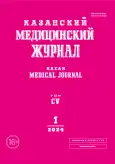Experience in the treatment of lymphatic malformations in children
- Authors: Zykova M.A.1, Nurmeev I.N.2, Mirolubov L.M.1,2, Valeeva G.R.1,3, Morozov V.I.1,2
-
Affiliations:
- Children's Republican Clinical Hospital
- Kazan State Medical University
- Kazan (Volga Region) Federal University
- Issue: Vol 105, No 1 (2024)
- Pages: 137-144
- Section: Clinical experiences
- Submitted: 09.02.2022
- Accepted: 24.07.2023
- Published: 02.02.2024
- URL: https://kazanmedjournal.ru/kazanmedj/article/view/100427
- DOI: https://doi.org/10.17816/KMJ100427
- ID: 100427
Cite item
Abstract
BACKGROUND: In the treatment of lymphatic malformations, the problem of radical removal and a high risk of recurrence remains.
AIM: Improving the efficiency of treatment of children with lymphatic malformations by introducing new surgical methods and optimizing sclerotherapy.
MATERIAL AND METHODS: The results of treatment of 150 patients with lymphangiomas and an experimental study of the effects of sclerosing drugs on the lining of lymphangioma are presented. The study included 67 (44.7%) girls and 83 (55.3%) boys. The patients were divided into three groups. The first group (72 children) consisted of patients with radical removal of lymphangioma. The second group included 70 patients with partial resection of lymphangioma and sclerosis of residual cavities. The third group (8 children) consisted of patients operated on by video endoscopic method. A histological study of micropreparations of lymphangioma after sclerosis with ethanol and sodium tetradecyl sulfate with an exposure of 5 minutes was carried out. Statistical analysis was carried out using the StatTech v. 2.2.0 using methods of parametric and non-parametric analysis. Results were considered statistically significant at p <0.05.
RESULTS: In the first group of patients, 9 (11.1%) relapses occurred, in the second — 12 (12.3%), in the third group — 0 relapses. Treatment combined with sclerotherapy did not lead to a significant increase in the recurrence rate (p=0.541). Types of lymphatic malformations and their location did not significantly affect the risk of recurrence (p=0.232 and p=0.552, respectively). Sclerosis of the lymphangioma lining with 70% ethanol and a liquid form of sodium tetradecyl sulfate caused total desquamation of the endothelium. Sclerosing with the foam form of sodium tetradecyl sulfate led to total desquamation of the endothelium during a 3-minute exposure.
CONCLUSION: The introduction of minimally invasive methods of treatment and the improvement of sclerosis will make the results of treatment of children with lymphangiomas better.
Full Text
About the authors
Maria A. Zykova
Children's Republican Clinical Hospital
Author for correspondence.
Email: sana86.86@mail.ru
ORCID iD: 0000-0002-1237-3547
M.D., Cand. Sci. (Med.), Children's Republican Clinical Hospital
Russian Federation, Kazan, RussiaIldar N. Nurmeev
Kazan State Medical University
Email: nurmeev@gmail.com
ORCID iD: 0000-0002-1023-1158
M.D., D. Sci. (Med.), Prof., Depart. of Pediatric Surgery
Russian Federation, Kazan, RussiaLeonid M. Mirolubov
Children's Republican Clinical Hospital; Kazan State Medical University
Email: mirolubov@mail.ru
ORCID iD: 0000-0002-2712-8309
M.D., D. Sci. (Med.), Prof., Head of Depart., Depart. of Pediatric Surgery
Russian Federation, Kazan, Russia; Kazan, RussiaGuzel R. Valeeva
Children's Republican Clinical Hospital; Kazan (Volga Region) Federal University
Email: egalisa17@gmail.com
ORCID iD: 0000-0002-1005-0568
M.D., Cand. Sci. (Med.)
Russian Federation, Kazan, Russia; Kazan, RussiaValery I. Morozov
Children's Republican Clinical Hospital; Kazan State Medical University
Email: morozov.valer@rambler.ru
ORCID iD: 0000-0001-5020-1343
M.D., D. Sci. (Med.), Prof., Depart. of Pediatric Surgery
Russian Federation, Kazan, Russia; Kazan, RussiaReferences
- Karmazanovsky GG, Stepanova YuA, Dubova EA, Zhurenkova TV, Kriger AG. Cystic lymphangioma of the pancreas: possibilities of radiology. Medical visualization. 2009;(3):94–100. (In Russ.)
- Chundokova MA, Uvarova EV, Shafranov VV, Velskaya YuI, Volkov VV, Emirbekova SK, Voyna SA, Anisimova EA. Perineal lymphangioma in an 8-year-old girl (clinical observation). Pediatric and adolescent reproductive health. 2015;(1):44–49. (In Russ.)
- Jo VY, Fletcher CD. WHO classification of soft tissue tumours: An update based on the 2013. 4th edition. Pathology. 2014;46(2):95–104. doi: 10.1097/PAT.0000000000000050.
- Parsi K. Congenital vascular malformations. Young-Wook Kim, Byung-Boong Lee, Wayne F. Yakes, Young-Soo Do, editors. Berlin Heidelberg: Springer-Verlag; 2017. р. 241–256. doi: 10.1007/978-3-662-46709-1_34.
- Sadick M, Müller-Wille R, Wildgruber M, Wohlgemuth WA. Vascular anomalies (part I). Classification and diagnostics of vascular anomalies. Rofo. 2018;190(9):825–835. doi: 10.1055/a-0620-8925.
- Nurmeev IN, Zykova MA, Mirolyubov LM, Podshivalin AA. Children with lymphatic malformations and their treatment using video-endoscopic equipment. Russian Bulletin of Perinatology and Pediatrics. 2020;65(5):232–238. (In Russ.) doi: 10.21508/1027-4065-2020-65-5-232-238.
- Kaipainen A, Chen E, Chang L, Zhao B, Shin H, Stahl A, Fishman SJ, Mulliken JB, Folkman J, Huang S, Fannon M. Characterization of lymphatic malformations using primary cells and tissue transcriptomes. Scand J Immunol. 2019;90(4):e12800. doi: 10.1111/sji.12800.
- Müller-Wille R, Wildgruber M, Sadick M, Wohlgemuth WA. Vascular anomalies (part II): Interventional therapy of peripheral vascular malformations. Rofo. 2018. doi: 10.1055/s-0044-101266.
- Poddubnyy IV, Ryabov AB, Tru-nov VO, Kozlov MYu, Topilin OG, Manukyan SR, Mordvin PA, Tverdov IV. The clinical case of the surgical treatment of cystic lymphangioma of the complex anatomical localization in child aged of 1 year 7 months. Detskaya khirurgiya. 2018;22(3):155–157. (In Russ.) doi: 10.18821/1560-9510-2018-22-3-155-157.
- Polyaev YuA, Petrushin AV, Garbuzov RV. Minimally invasive methods of treating lymphangiomas in children. Detskaya bolnitsa. 2011;(3):8–12. (In Russ.)
- Roginskiy VV, Nadtochiy AG, Ovchinnikov IA, Gavelya EYu, Pavelko GA, Babichenko II, Lomaka MA, Ryzhov RV. Malformations of the lymphatic system of the head and neck in children: diagnosis and treatment methods. Onkopediatriya. 2015;2(3):324–325. (In Russ.)
- Bouwman F, Kooijman SS, Verhoeven BH, Schultze Kool LJ, van der Vleuten C, Botden S, de Blaauw I. Lymphatic malformations in children: Treatment outcomes of sclerotherapy in a large cohort. European Journal of Pediatrics. 2021;180(3):959–966. doi: 10.1007/s00431-020-03811-4.
- Woolman J. History of sclerosants foams: Persons, techniques, patents and medical improvements. In: Bergan J. Foam sclerotherapy: A textbook. Van Le Chang, editor. London: Royal Society of Medicine Press; 2008. 248 p.
Supplementary files









